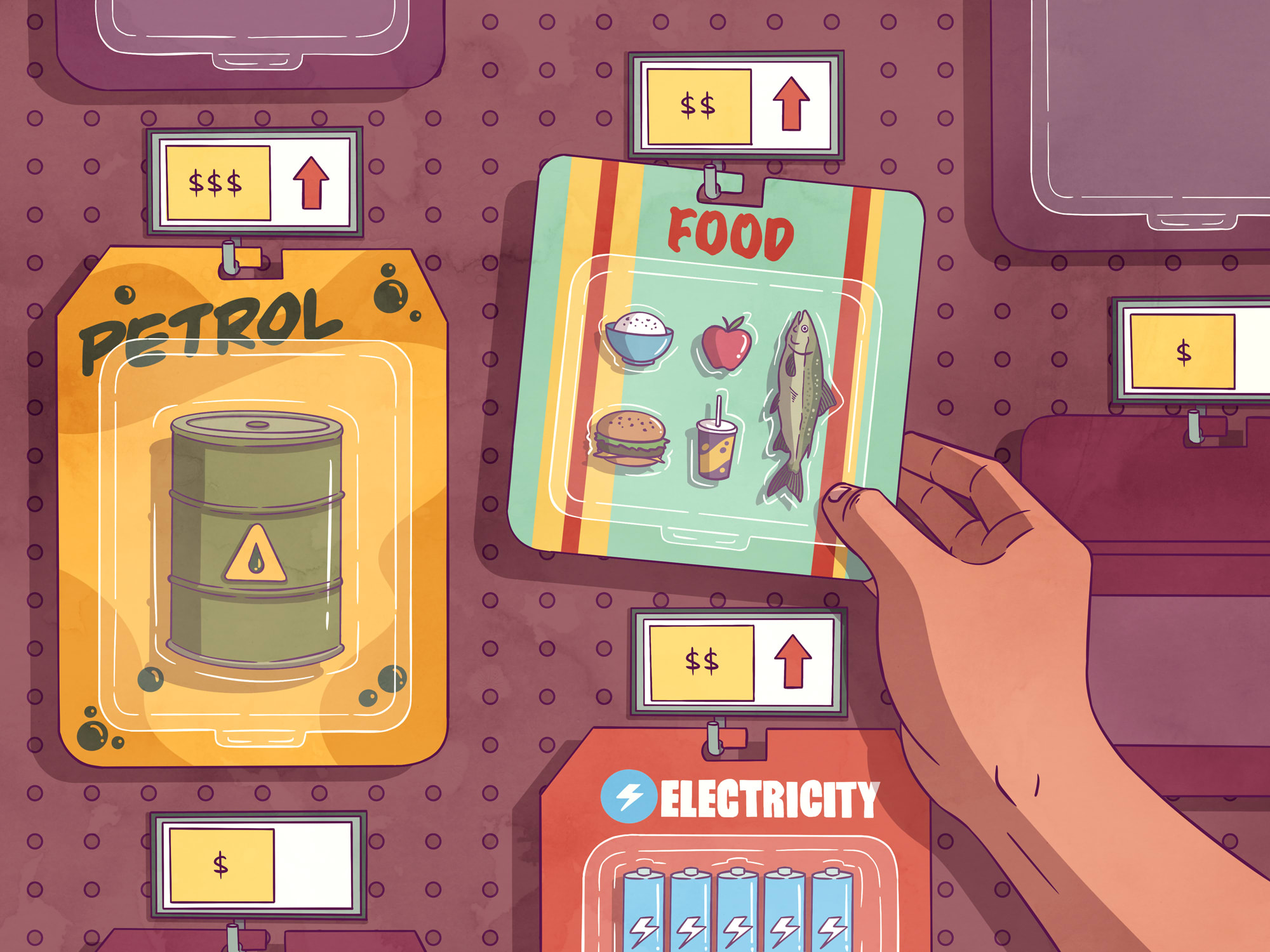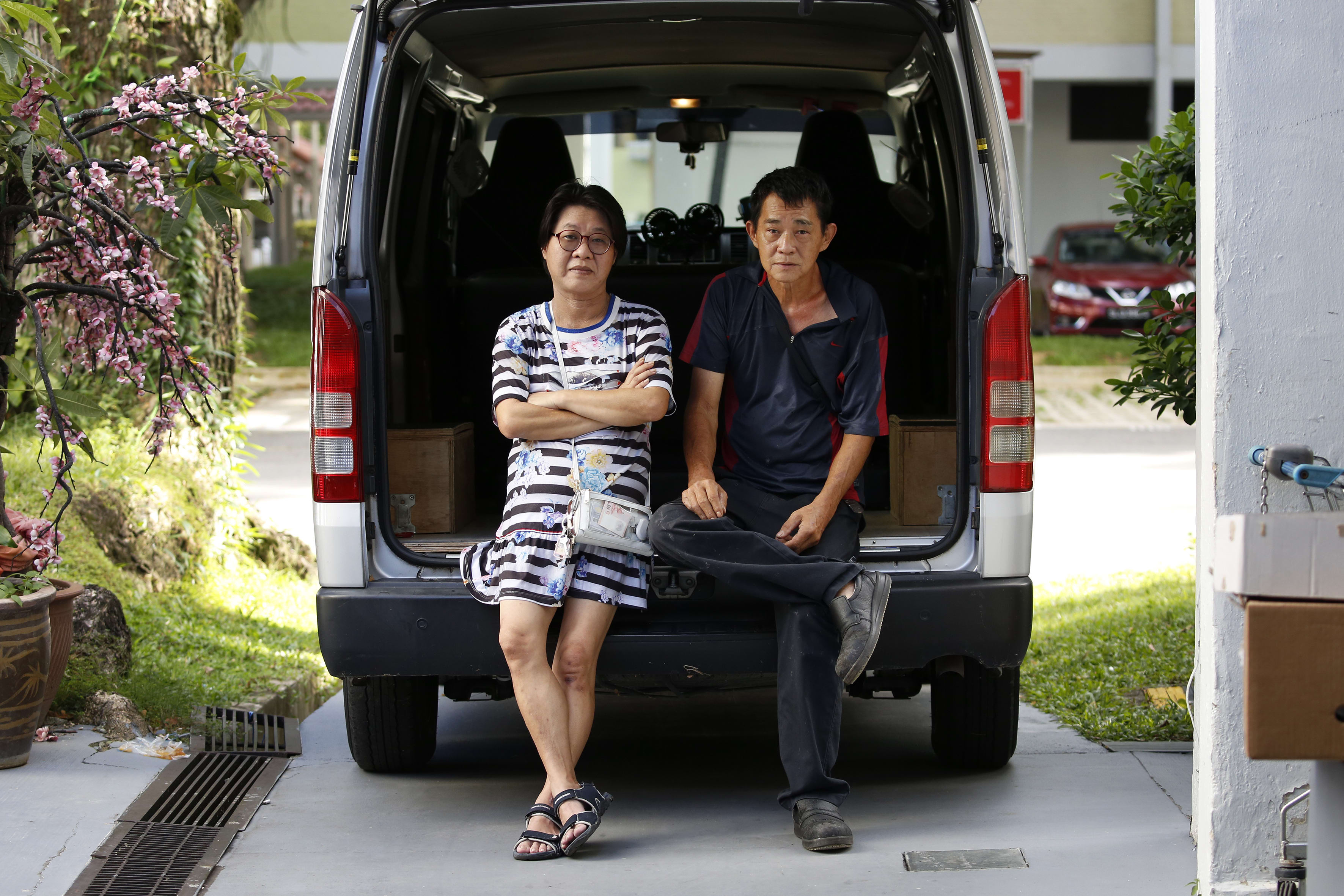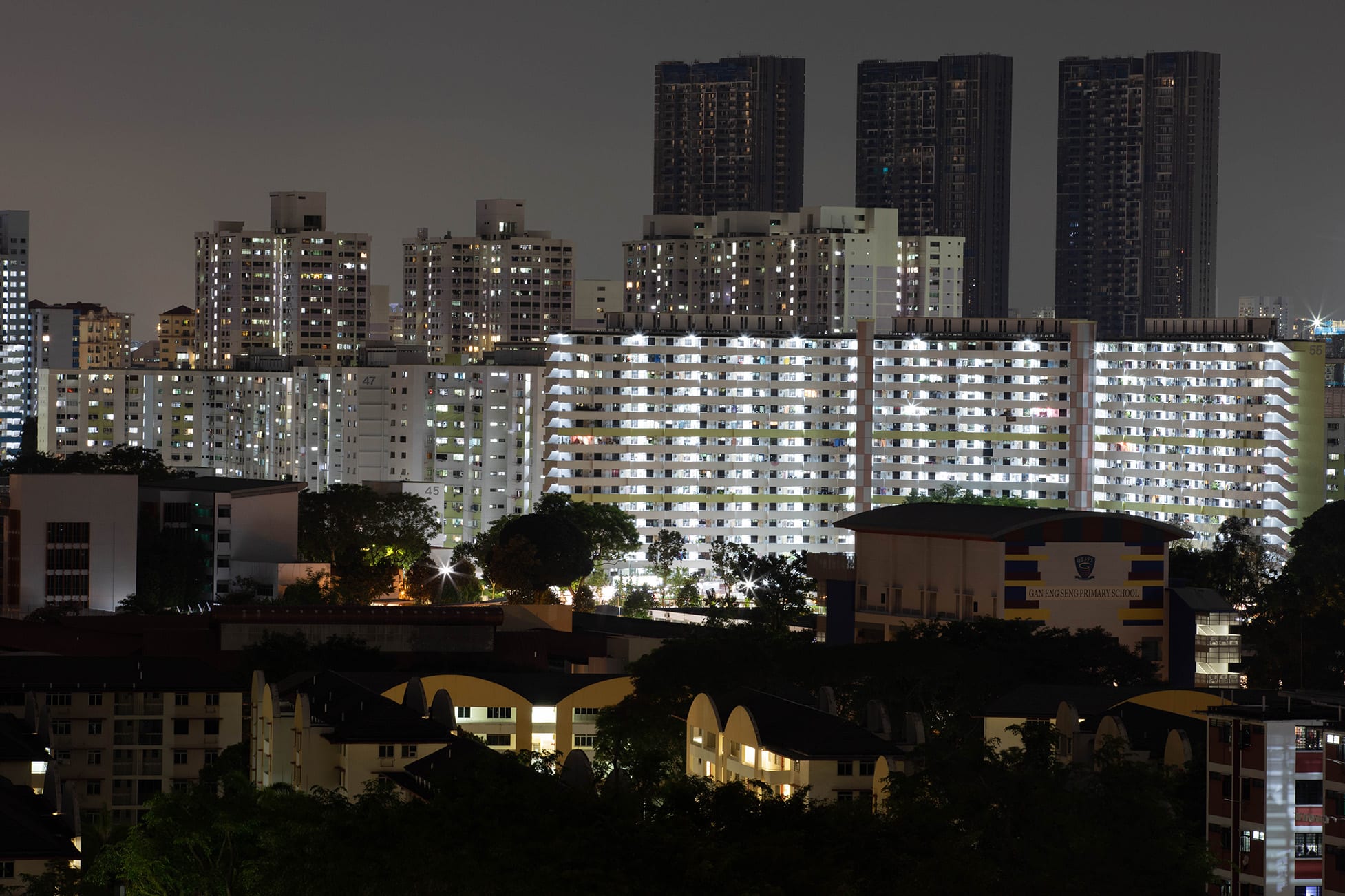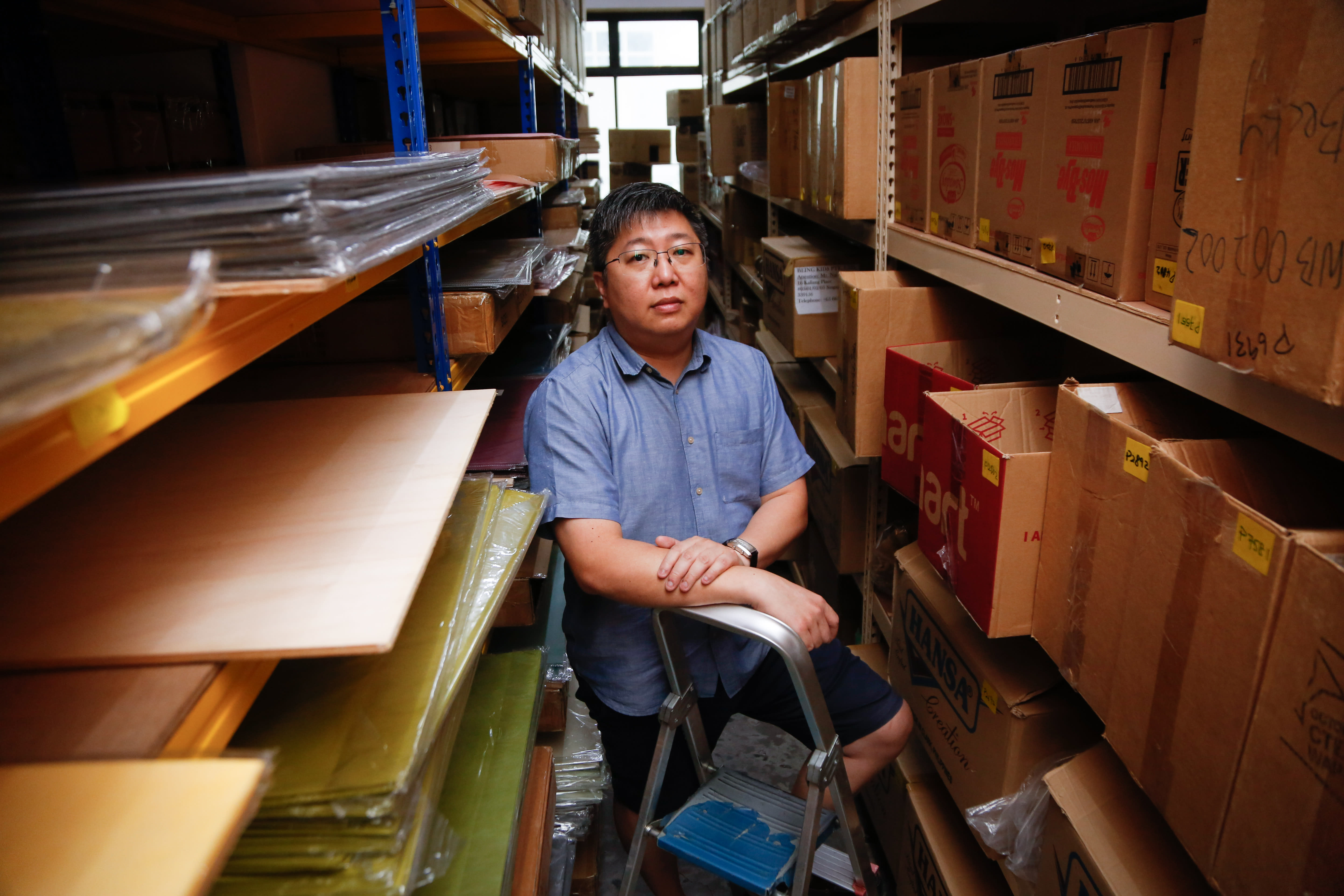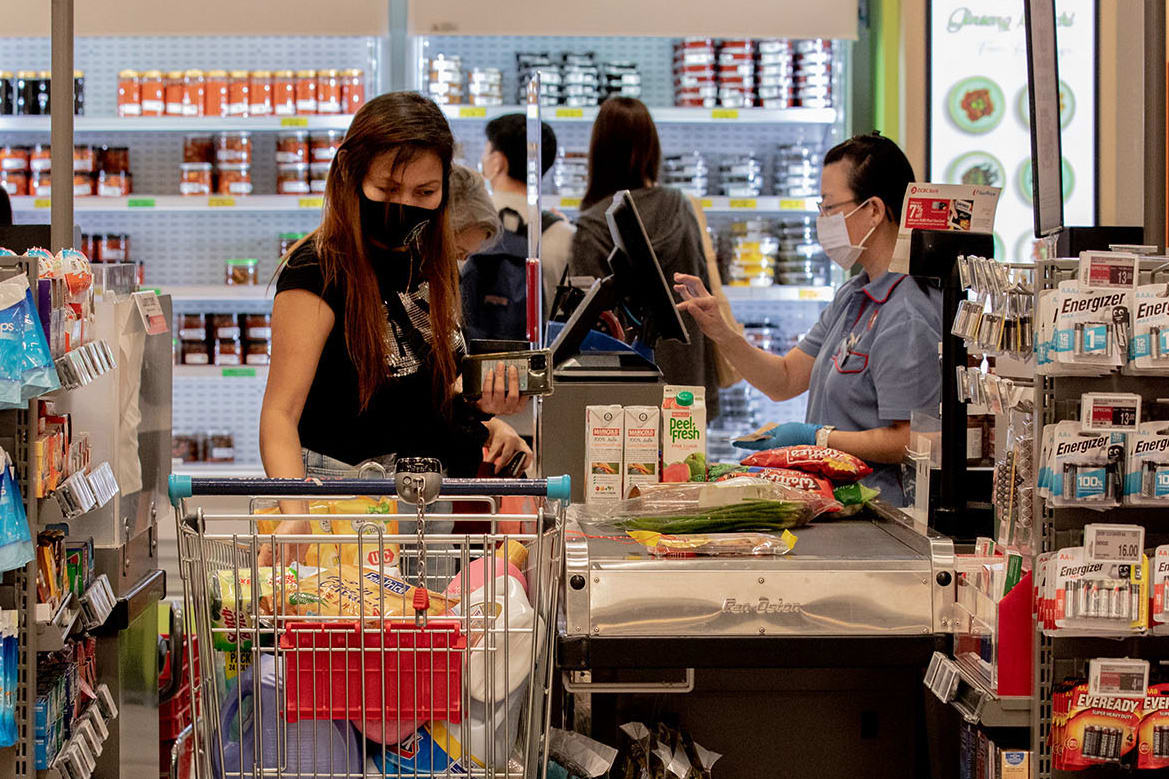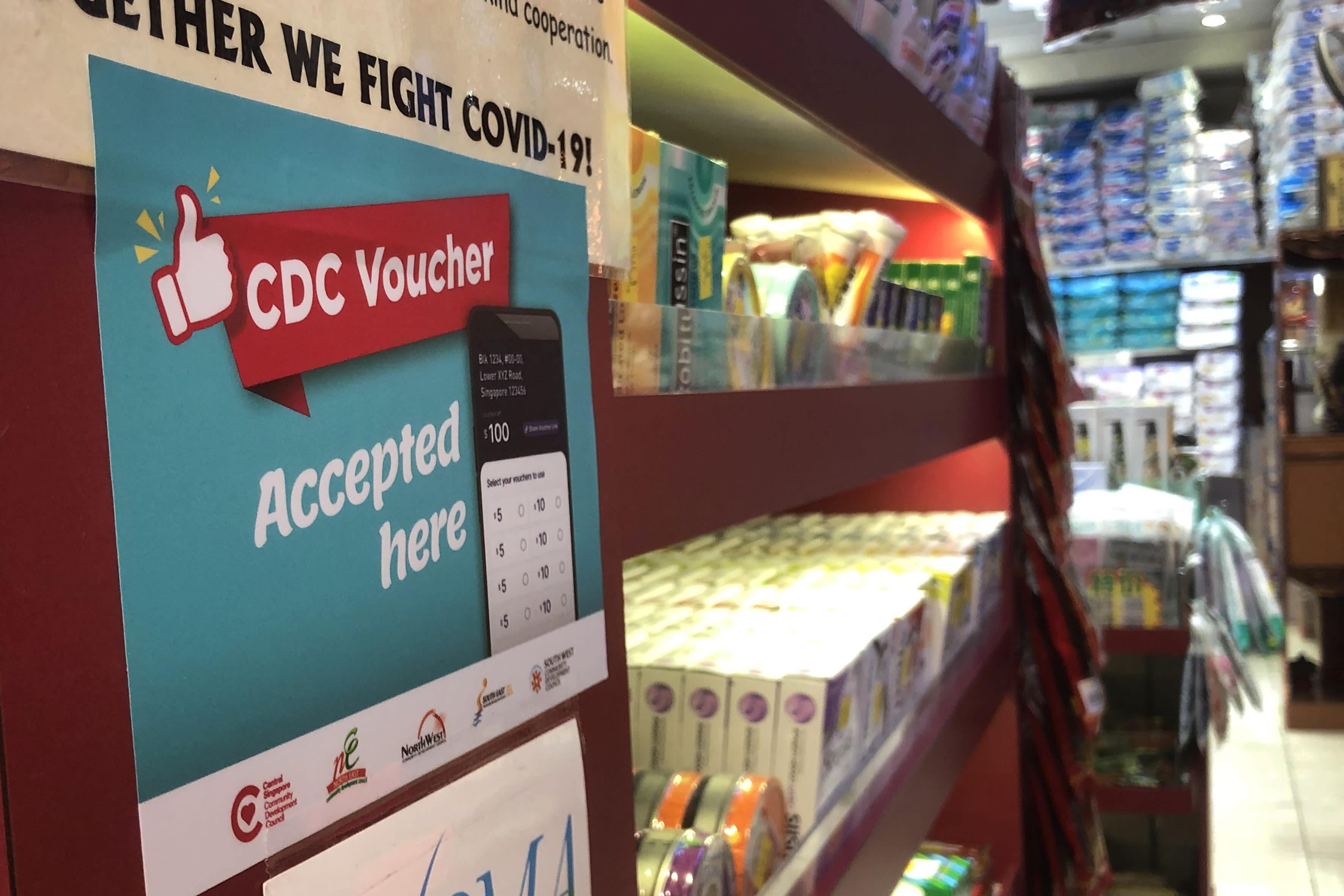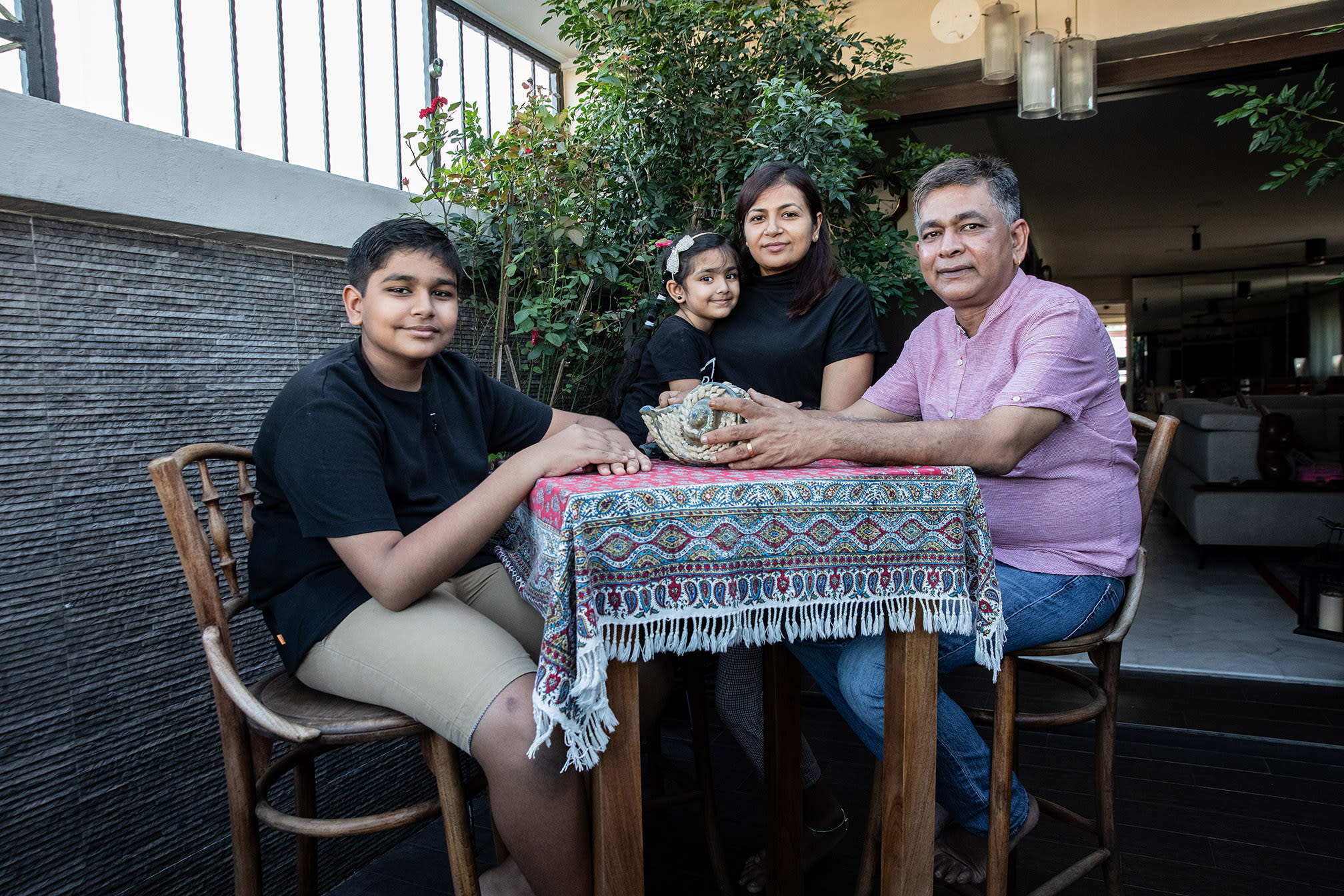The Big Read: Singapore households, businesses not spared from global inflation storm as GST increase looms
Illustration: Anam Musta'ein
- Inflation is set to be a key challenge in 2022, as households face rising prices on multiple fronts, ranging from food to electricity
- Business also face higher freight fees, manpower costs due to border restrictions and supply chain disruptions due to measures to contain the spread of Covid-19.
- Prices look set to go up even more with the impending increase in GST from 7 per cent to 9 per cent
- MPs say grassroots initiatives are up and running to help households, while economists point to possible policy levers to mitigate the impact of rising living costs
- Families facing the brunt of inflation have started belt-tightening, while businesses are looking at raising prices

BY
@janicelimtoday

BY
Published January 8, 2022
Updated January 8, 2022
WhatsAppTelegramFacebookTwitterEmailLinkedIn
SINGAPORE — Before the Covid-19 pandemic struck about two years ago, housewife Suria Saini would spend about S$400 a month on groceries and other basic necessities.
But as of December last year, her monthly spending has gone up to over S$500 on the same list of items.
“I always go to the same shops, the same stalls in the market. There seems to be a 50- to 80-cent increase on most things like shampoo and detergent. Fish, mutton, chicken… Prices have gone up so much,” said Mdm Suria, 47.
Her husband earns S$1,200 a month working in pest control and the couple has 14 children, four of whom are working but still living in the family's four-room flat and contribute "not much" to household expenses. Her children are aged between eight and 25 years old.
From December 2019 to February 2020, Mdm Suria had received Comcare cash assistance of S$350 a month, as well as subsidies for utilities and services and conservancy charges. Since then, the family does not get any Comcare assistance but her school-going children continue to receive government support for their school expenses.
Mdm Suria said she noticed that a carton of 30 eggs, which used to cost S$3, has gone up to S$5. The price of a packet of instant noodles has also increased from S$1.80 to S$2.20.
READ ALSO
“Our budget is really tight... Now that we know that everything is going to increase even more in 2022, can you imagine how I'm going to manage?” said Mdm Suria.
For Madam Sandy Goh, 54, the rising cost of expenses — on top of a drastic loss in income — is taking a toll on her family of five. She and her husband have three school-going children aged between 11 and 18.
Besides an increase in her monthly utility bills from S$180 to over S$280 at her three-room public housing flat, she observed that food prices have also risen. Canned pork is now S$4.50, instead of S$3.50, and a meal at a coffee shop now averages around S$4, compared with around S$2.50 to S$3 about two years ago.
Raj Nadarajan/TODAYMdm Sandy Goh, 54, runs a tentage services firm with her husband, Mr Cheah Kok Hwa, 58, but their business has taken a huge blow due to the pandemic. The rising cost of expenses — on top of a drastic loss in income — is taking a toll on her family of five.
The increase in costs of living comes amid financial hardship brought about by the pandemic, now into its third year. Mdm Goh, who runs a tentage services firm with her husband, said that her business has taken a huge blow as the crisis has curtailed the events industry and the couple’s savings are dwindling.
“It is very stressful for us. Now because of Covid-19, we don’t have any events to cover our rising expenses and at this age, we cannot even find part-time jobs,” she said.
Around the world, inflation is set to be a
key challenge this year, as prices rise on multiple fronts. Border restrictions and supply chain disruptions — a result of measures to contain the spread of Covid-19 — have also led to higher manpower costs and freight fees for businesses.
READ ALSO
In Singapore, families are facing higher prices in an array of goods and services, including for food,
public transport and
electricity.
The Monetary Authority of Singapore (MAS) has
highlighted the higher inflationary pressures and moved to
tighten its monetary policy in response.
The situation here is exacerbated by the recent spate of floods in Malaysia, driving up the imported costs of goods that Singapore gets from across the Causeway.
And prices are expected to go up further this year, with the impending increase in Goods and Services Tax (GST).
In his New Year message, Prime Minister Lee Hsien Loong said that the Government has to
“start moving” on the planned increase in GST from 7 per cent to 9 per cent.
The MAS had said in its October macroeconomic review that public transport fares could be raised again and healthcare subsidies may be phased out this year as well.
READ ALSO
MAS expects overall inflation for 2022 to come in between 1.5 and 2.5 per cent, up from around the projected 2 per cent in 2021. Core inflation, which strips out private transport and accommodation costs, is projected to rise between 1 and 2 per cent next year — higher than the upper end of the 0 to 1 per cent forecast range that MAS expects inflation to hit in 2021.
With multiple factors converging to push prices upwards, Ms Selena Ling, head of research and strategy at OCBC Bank, said the current situation is akin to an “inflation storm”.
"You not only have externally-driven imported inflation because of global supply chain disruptions... The question is whether some industries and firms are in a position to pass on the higher costs, not just from the GST hike, but also from the build up of higher operating costs," said Ms Ling.
Ili Nadhirah Mansor/TODAYIn Singapore, families are facing higher prices in an array of goods and services, including for food, public transport and electricity.
MIDDLE-INCOME ALSO FEELING THE PINCH
Mr Kelvin Seet, 43, who works in the aviation industry, said that his expenses have increased by at least 20 per cent since the start of 2020.
Despite coming from a middle-income household, he is feeling the pinch. He lives in an executive apartment flat with his wife, who is also working full-time, and three children aged between eight and 12 years old.
READ ALSO
He estimated that food prices at hawker centres have increased by about 20 per cent since pre-Covid, noting that the Western food stall in his area has raised its price of a spring chicken meal from S$9.90 to S$11.80.
His utility bill has also gone up by 20 per cent, and tuition fees for his children are increasing on a yearly basis.
But Mr Seet said his income has not increased over the past two years.
“I have not spent on any luxuries and just try to keep my family comfortable during this period," he said.
For 36-year-old Vincent Li, he has observed price increases on a wide range of expense items, such as property tax, refuse collection fees, wages of foreign domestic workers, childcare school fees, online purchases and electricity bills.
“Prices are going up while wages are only increasing by 2 to 3 per cent per year, which is unable to catch up with inflation,” said the business development professional in a tech firm. His combined monthly household income is around S$9,000.
READ ALSO
'ICE-THIN' PROFIT MARGINS FOR FIRMS
It’s not just families feeling the pinch.
Several business owners told TODAY that they have been feeling rising cost pressures in several aspects — manpower, logistics, raw materials and electricity.
With many retailers forced to go online as a result of Covid-19, digital marketing costs have also gone up.
Ms Ling noted that these rising costs are taking place against a backdrop of fading financial support from the Government, such as the Jobs Support scheme, which provides companies wage subsidies, and rental waivers.
Mr Terence Yow, who is the managing director of shoe retailer Enviably Me, said that each of these cost components has gone up by two or three times on average, and costs have gone up by between 12 and 15 per cent across the board.
READ ALSO
While the economy is recovering from its worst during the height of the pandemic, revenue is still down between 30 and 40 per cent, he said.
“Those (businesses) which have managed to survive till now… I think we are just trying to cope with every wave that comes on… What can we possibly do about freight fees, labour costs and GST? The alternative is to exit,” said Mr Yow, who is also the chairman of Singapore Tenants United For Fairness, which represents more than 770 business owners.
Mr Bernard Tay, the managing director of Jinjja Chicken, said that the operating costs for his Korean fried chicken business have increased by between 20 and 30 per cent last year, compared to 2020.
Describing food costs as “crazy”, Mr Tay said the price of one tin of cooking oil has gone up by 40 per cent.
Traditionally reliant on workers from Malaysia, border restrictions have also made it very hard for him to employ workers, and hence manpower costs have been going up to attract them.
“For the first time in my business, I have got the quota (to employ foreign workers) but I don’t have workers… You walk in a mall, which food and beverage (F&B) establishment is not putting up a hiring notice? And the salary offered is higher and higher. People can literally quit here today, and tomorrow work in the same mall in another outlet just next to mine,” he said.
While the return of dining-in for a maximum of five people has helped improve business, Mr Tay said the safe distancing requirement means that revenue is still below pre-pandemic levels.
“The margin is so thin like ice,” he added.
Another retailer Mr Keson Lim, the director of toys distribution firm Being Kids, also said that his business costs have jumped by a similar amount of 20 to 30 per cent.
In addition to a bump in freight costs, he has to contend with manpower shortage. Besides difficulties in hiring foreign workers to replace those who have quit to return home, Mr Lim said his traditional reliance on part-timers has been affected, as many of them are now working as swabbers or safe distancing ambassadors.
Raj Nadarajan/TODAYMr Keson Lim, the director of toys distribution firm Being Kids, said that his business costs have jumped by 20 to 30 per cent.
“The jump in costs was quite drastic, while recovery of revenue wasn’t that fantastic,” said Mr Lim.
“Many businesses that were profitable in 2019, were unprofitable in 2021 due to cost increases.”
Mr Yow said that businesses are stuck between a rock and a hard place, as they can’t keep absorbing cost increases.
“When sales are already down, it’s a very difficult choice to risk customers not being happy by increasing prices during such a difficult time. Most of us will try not to. But inevitably, I think there is no choice, prices will have to rise,” he said, adding that this is not even taking into account cost pressures from the GST increase.
Mr Tay said he has not raised prices of his Korean fried chicken in the last two years, but may look to increase it by 50 cents or S$1 to cushion the impact of the rising costs.
He reiterated that he cannot adjust prices too much, as consumers are now more price sensitive than they were pre-pandemic, as some may have lost their jobs or suffered a drop in income.
And he may have to increase prices again, if the Government decides to implement a 2 percentage point GST hike at one go. While it is industry practice among fast-food chains to absorb GST, Mr Tay said he would not be able to do so this time due to other cost increases.
However, if the increase is done in a staggered manner, whereby GST is raised by 1 percentage point first, Mr Tay said he may consider absorbing the GST, but it will have to depend what others in the industry do.
As for Mr Lim, he has already sent a notice to his corporate clients that they would have to increase prices by 10 per cent from this year, without even factoring in the impending GST increase.
“We did a marginal 10 per cent (price increase) to reduce the negative impact on ourselves. It’s not even to be profitable,” he said.
Like Mr Yow, Mr Lim said that if the current cost pressures persist, he would not be able to absorb the GST increase. However, he noted that the decision on whether to pass on the tax to consumers would largely depend on what will be announced during the Feb 18 Budget statement, and whether the authorities would further ease border restrictions in the next few months.
“Pre-Covid, absorbing the 2 percentage point increase would not have been an issue at all,” said Mr Lim.
TIMING OF GST INCREASE
Economists had previously told TODAY that 2022 provides
a window of opportunity for the Government to implement a GST increase, even though there is never a good time to raise taxes.
For one, the Singapore economy is on firmer footing compared to last year, when it was just coming out of its trough in 2020 after being hammered by the pandemic.
Plans to raise the GST from 7 to 9 per cent between 2021 and 2025 were first announced in 2018 by then Finance Minister Heng Swee Keat, who is now Deputy Prime Minister. The purpose is to raise the Government’s revenue due to an expected increase in recurrent spending, especially in healthcare, as Singapore grapples with an ageing population.
But Covid-19 pandemic threw a spanner in the works. With Singapore then in the early stages of the pandemic, Mr Heng announced during Budget 2020 that the increase
would not take place in 2021.
He said that the decision to not raise the GST last year came about after the Government reviewed its revenue and expenditure projections and considered the current state of the economy. However, it cannot be postponed indefinitely, he stressed.
The unprecedented crisis has also led the Government — on top of its usual spending — to commit nearly S$100 billion through five Budgets to help Singaporeans and businesses. The Government had to dip into the country's past reserves to fund the various assistance schemes, making the need to replenish the official coffers more urgent than ever, some economists have noted.
DBS senior economist Irvin Seah believes that the GST increase will be implemented in July and the Government will raise the tax by 2 percentage points in one go.
A one-step jump will limit the long-term impact of the increase, and the effect on overall inflation should fade away in 12 months, said Mr Seah.
While Ms Ling also thinks that the higher GST could kick in as early as July, she believes that a more gradual approach, in the form of a staggered increase, would not result in knee-jerk reactions from consumers.
Ili Nadhirah Mansor/TODAYEconomists had previously told TODAY that 2022 provides a window of opportunity for the Government to implement a GST increase, even though there is never a good time to raise taxes.
Ms Ling estimates overall inflation this year to be around 2 to 3 per cent. Wage growth would have to be above that to offset the effects of the GST increase, she noted.
Mr Seah said that the labour market is showing signs of improvement, particularly for the finance, info-communication and technology industries.
Wages in these sectors would likely rise, though such growth would not likely occur across the economy.
“For the labour market to improve and wage growth to rise, we need the economy to be on a firmer footing. That will really depend on how soon we are able to reopen the economy,” said Mr Seah.
SUPPORT FOR HOUSEHOLDS
The Government has earlier announced that it will set aside a S$6 billion package to help lower-income households cope with the planned increase in GST. Every adult Singaporean will receive a cash payout of between S$700 and S$1,600 over five years, depending on factors such as the type of public housing flat they live in.
The Government also recently launched the
Community Development Council vouchers, where every Singaporean household will each receive S$100 worth of the vouchers which may be used at participating hawker centres and businesses in the heartlands.
Speaking to TODAY, Members of Parliament (MP) said that some residents have been seeking assistance amid the rising cost of living.
Sembawang Group Representation Constituency (GRC) MP Mariam Jaafar said that quite a number of her residents have sought help to secure new Housing and Development Board (HDB) flats, apply for rental flats, or asked for rental rates to be reduced. She said they were priced out of the resale HDB market as they could not get a high enough home loan or could not continue with their mortgage payments.
The MPs also said they are running several grassroots initiatives to help needy residents.
Ms Mariam said there are schemes for low-income residents in Sembawang GRC to get free cooked meals at hawker centres or coffee shops, free food and other household essentials at a community minimart, as well as financial assistance for utilities, diapers and emergency repairs.
A grant was also introduced to help those who do not meet the qualifying requirements for government financial assistance, she added.
To ensure his residents get the help they need, Yio Chu Kang MP Yip Hon Weng said he is trying to build stronger links between the Government and social service agencies, so that needy families can get help promptly.
Some residents have also formed a support group to get neighbours to encourage more people to volunteer at food banks, donate computers, or provide free tuition, he said.
Mr Zhulkarnain Abdul Rahim, MP for the Keat Hong ward of Chua Chu Kang GRC, said that his team of volunteers has organised job fairs, distributed care packs and vouchers to the elderly or low-income households, as well as those affected by the pandemic. They have also worked with private and community donors to help families reduce their household expenses.
Over at the Cheng San-Seletar ward at Ang Mo Kio GRC, MP Nadia Ahmad Samdin said that her team has reached out to residents who face other challenges such as caregiver burden, instead of just focusing on their level of income.
Repairing initiatives have also popped up in her ward, she said. These help to lengthen the lifespan of laptops and other electronic learning devices for families who may be facing financial hardship and are not able to replace these items.
Raj Nadarajan/TODAYThe Government also recently launched the Community Development Council vouchers, where every Singaporean household will each receive S$100 worth of the vouchers which may be used at participating hawker centres and businesses in the heartlands.
POLICY LEVERS TO MITIGATE IMPACT
Amid the slew of grassroots activities to mitigate rising living costs, monetary policy moves by the MAS would also help to cushion the impact of inflationary pressures in the medium term, said the economists.
They viewed the tightening of the monetary policy in October as an anticipatory move by the central bank, and there may be another round of tightening again in April.
This is because a strong Singapore dollar would mean that the costs of imported goods would go down, though there is a limit to how much the MAS can tighten since having a currency that is too strong would affect Singapore’s export competitiveness.
While these grassroots initiatives and medium-term policy levers are important to help Singaporeans cope with rising costs, economists said that the longer-term solution would be to keep the economy vibrant, have foreign investment continue flowing in and creating jobs.
They noted that special transfers by the Government and GST vouchers are temporary and are meant to help Singaporeans through the transition period.
If these assistance schemes are permanent, they would defeat the original intent of hiking GST to raise revenue in the first place, noted OCBC’s Ms Ling.
“If the Government expenditure is going up through fiscal transfers, it ends up as a circular argument. Where are we going to find the tax revenue to pay for all this?” she said.
Another more long-term solution is for the Government to index its various financial assistance payments to rising costs of living from year to year, said labour economist Walter Theseira from the Singapore University of Social Sciences.
Many of these payouts under the Workfare Income Supplement or Silver Support schemes are fixed monetary amounts that are adjusted periodically. But Associate Professor Theseira said this means that these payments lose purchasing power during the unadjusted years.
While it is not normally an issue when inflation is low and stable, it can be problematic when prices go up faster than expected.
“The policy intent is not to give a sum of money, but to address cost of living issues. If the cost of living changes over time, the payments ought to change,” he said.
Incorporating an indexation process into these various payout schemes is not that different from what the Public Transport Council does, when it increases fares to keep pace with the costs of operating the system.
“If you index prices, why can’t you index payouts? These payouts would allow Singaporeans to afford the same standard of living before price changes take effect,” said Assoc Prof Theseira.
He added that it’s also important that any GST increase is matched with other tax increases that capture more revenue from capital and higher-income taxpayers, to ensure the tax system remains progressive.
Mr Seah said that even though raising the GST would affect the lower-income more, moves to increase the property tax rate of those living in bigger HDB flats, as well as the recent cooling measures, are tax measures that affect the middle and higher-income earners in Singapore.
And these measures, in totality, ensure that Singapore’s tax system remains progressive.
INDIVIDUALS TIGHTEN THEIR BELTS
In response to TODAY’s queries, supermarket chains said that they have also faced rising operating costs due to rising energy prices, supply chain disruptions and seasonal weather changes.
A Sheng Siong spokesperson said that it has been diversifying its sourcing and procurement strategy to “keep supplies of its products stable and affordable throughout the year and in times of crisis”.
A FairPrice spokesperson said that it tries to keep prices of daily essentials affordable and stable by stockpiling daily essentials, as well as forward buying and diversifying its import sources to over 100 countries.
Its housebrand products are also at least 10 to 15 per cent cheaper than comparable brands.
As for Giant, which is owned by DFI Retail Group, a spokesperson said that the supermarket chain has lowered the prices of essential goods by an average of 20 per cent.
Products under its own in-house brand, Meadows, which was launched in August 2020, are on average 20 per cent cheaper, it added.
While supermarket chains are employing various strategies to keep prices affordable, individuals themselves are already tightening their own belts.
Mr Asokh Singh, 49, now prefers to make trips to Little India to buy his groceries instead of buying them from supermarkets near his home, where the prices of vegetables are at least 50 to 80 cents higher, he said.
Ili Nadhirah Mansor/TODAYMr Asokh Singh (right), 49, with his wife and two children in their home at Pasir Ris on Jan 6, 2022. Mr Singh now prefers to make trips to Little India to buy his groceries instead of buying them from supermarkets near his home, where the prices of vegetables are at least 50 to 80 cents higher, he said.
He used to earn around S$8,000 a month as a general manager of a travel agency, but it has since been cut to around S$2,000 due to the Covid-19 impact on the travel industry.
“Last time I had a different lifestyle but now every cent matters… I will try to find cheaper alternatives to make my purchases. If I find a wholesale place, even better so I can save more money,” said the father of two school-going children.
Mr Singh also sold his car in November last year and began renting out two rooms in his five-room HDB flat about six months ago. He is looking to sell his house and move to a smaller one.
As for Mr Li, the business development professional, he is also renting out a room in his four-room HDB flat. On top of that, he has stopped hiring a domestic helper and reduced the number of enrichment classes for his three-year-old child.
He and his family also dine out less and “think twice” before buying new electronics.
For stay-at-home dad Lim Guan Seng, 42, he has resorted to skipping lunch at home and cutting back his spending on subscription-based services, such as Netflix. This was after he noticed that his monthly expenses on groceries and utilities going up from S$1,200 to S$1,500.
A cup of bubble tea or a McDonald's meal are now luxuries that he would hesitate to indulge in.
“The money saved can be better used for enrichment for the kids and perhaps even more nutritious food,” said Mr Lim, who has a wife working in a logistics firm and three children aged between four and eight years old.
While the Government has pledged to help Singaporeans cope with the GST increase, some families are bracing themselves for leaner times amid the rising living costs on other fronts.
Mdm Suria said that she would have to discuss budgeting with her family sometime soon, recalculate their expenses and make the necessary adjustments.
“What can I do? We all have to go through (this period of rising costs) whether you like it or not… We just go on,” said Mdm Suria.
